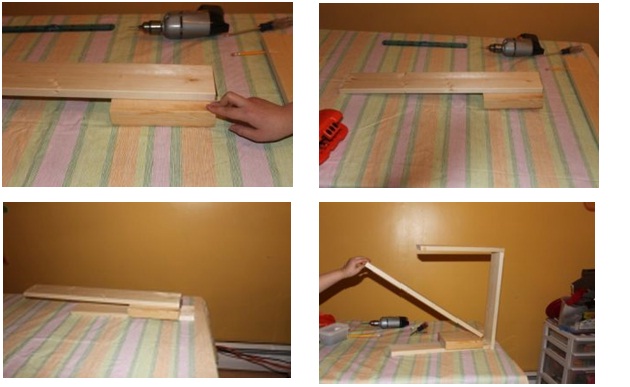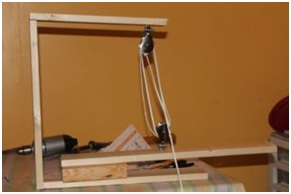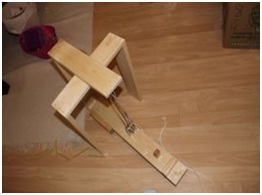





Published on Sep 16, 2023
The objective: Our project was to try and create a variation of a teeter-totter for one person. The goal was to create a compound machine using pulleys and levers that would be able to lift a barbie up and down. A common problem on the playground is that you sometimes can't find another person to go on the teeter totter with you. We thought that if created a structure that allowed children to "teeter-totter" on their own, it could revolutionize solo play! Our hypotheses was that by using a block and tackle system, a person could operate a machine on their own. We wanted to move the hinge to the end of the teeter-totter to avoid the feeling that someone needed to be on the opposite side. We felt that the more pulleys we used, the easier it would be for the person to pull themselves up. This was based on the research we did beforehand. We thought that we would need to build a frame over the "teeter-totter" to hold the pulley and support the weight of the person.
This project will be about these four things we will be using, along with mechanical advantage. We will be explaining about two different simple machines and forces. We want to invent a compound machine made out of at least two simple machines.
A pulley is a is a wheel with a grooved rim so that a rope or a cable can go through without slipping off. It changes the direction to lift a load. There are different types of pulleys. One type is a fixed pulley which is a pulley that is joined to a fixed object, such as a bar. An example of a fixed pulley is a flag pole that has a fixed pulley at the top and a rope that goes from the bottom and top which lifts the flag upwards. Then there is the movable pulley. This pulley is often attached to fixed pulleys. What you need to make a movable pulley is a long piece of rope that is tied to a bar or a rod.
Then put the other end of the rope and attach it to a bucket and pass the rope to the bar. When you pull on the side that doesn’t have the load then you will lift up the load by mechanical advantage. When there is many fixed and movable pulleys that are combined together it is called a Block and Tackle. This helps cranes and other big devices to lift a very heavy load. Even the most powerful engines can’t lift a load without the help of a pulley. A block and tackle is many pulleys on the top and bottom of something making it easier to lift heavy loads. The more pulleys you have the easier it is to lift things, but the more you have to pull.
The lever is a simple machine that has a fulcrum, a force and a load. Everything balances on the lever arm. The fulcrum is the part of the lever that doesn’t move. The lever arm is a shaft placed on top of the fulcrum and the force moves the load. If you look at a shovel while you are shoveling, your top hand is the fulcrum, your middle hand is the force, and whatever you are shoveling is the load. A shovel is a lever. A see saw is also a lever. The middle part under the shaft or board, is the fulcrum. The force is the person who is pushing at the moment and the load is the person who the force is pushing.
Gravity is a natural force that makes everything on earth come down to the center of the earth. Some examples of gravity is when a snowboarder goes down a mountain or when water falls. The strength of gravity counts on the objects mass which is how much matter is in the object. Earth has a humungous amount of mass in it. Why does earth have so much gravity? It is because the larger the object the more gravity it has and heavier it is. Some even say that gravity and weight is the same thing. Isaac Newton is a famous scientist who is the first scientist to discover gravity, and he found out most of what we know about gravity. He has made books and one called Principia Mathematica about his studies.
• Wood plank
• pencils(in half)
• 4 - 6 pulleys
• Hinge
• Seat (Hockey stick)
• Hot glue gun
• String / thin rope
• Barbie (“person”)
• bead
• pencil
• power drill and screws/nails
• small weight
1. First get all your materials
2. Then get your pencil and mark with your hinge where you want the hinge to go.
3. Put your screws in your marks with the hinge.
4. Attach another block of wood to the bottom leaving a space for the weight.
5. then after nail a block of wood to the bottom going vertically.
6. Attach another block of wood attaching to the top one.
7. For balance take your last two blocks of wood and attach them to the sides of the top one.
8. Put on your pulleys on the top wood and the lever wood which is at the top which is attached to the hinge, put your string in as well.
9. Taking your halves of pencils put them on each side of your bottom pulley.
10. Put on your hockey stick seats at the end of the wood that is on the top attached to the hinge.
11. Use your scissors to cut the extra string and attach the bead.(optional)
12. Put your weight at the end and put the barbie on.
13. Pull the string attached to the pulley and the board to lift it up.

1.This was the first step of the process, we made this with a square piece of wood and a long piece of wood attached with a hinge.
2.This is the same step but showing the problem we had of having it unbalanced.
3.This was the next step and we fixed the problem with the unbalance with another block of wood on the bottom.
4.This part we showed you the top bar we used to attach the pulley with and how the lever works.

This picture is of the pulley we attached to the top bar and the bottom bar.

This was our finished project
We learned a lot while finishing our project. We learned about gravity, friction, and simple machines. For our final project, we used screws, pulleys, and levers to create our one-person see-saw. Gravity was a problem when we were trying to find a way to lift the wood with and without a person on it. One of our solutions to gravity was to use a spring, but that didn't work. Instead we used a pulley, string and arm muscles to beat gravity. Also we used a block and tackle system to make it easier for the person to pull themselves up and down. The more pulleys you have, the easier it is to pull.
Friction was also a problem we thought about when we were attaching our pulley to our compound machine. We had to find a rope that would minimize friction, and make it easier to pull the wood up in the air. You can learn more about what we learned on our "essay" page. While we were building, we had to make adjustments to our plan. When our bottom pulley kept falling over, we glued pencils on it to hold it upright. When the overhead bar that holds the pulley was unstable, we had to make a frame to hold it. We had a lot of fun building our compound machine.
It was interesting solving problems when they popped up that we didn't expect. You create a plan on paper, but when you start building, you sometimes need to make changes to your plan. When you are building a playground structure, you really need to think about safety. When kids come to a playground, they like to see fun new and interesting things to play on. We think if our one person teeter totter was added to a playground, children would love it. We think this is a fun and safe invention!
Ardley, Neil. "The Science book of Gravity" London Dorling Kindersley Limited London 1992
Armentrout, Patricia. "The Lever" The Rourke Press, Inc. 1997
Armentrout, Patricia. "The Pulley" The Rourke Press, Inc 1997
Johnston, Tom. "Forces with you" London This US edition copyright 1988
Manolis, Kay. "Gravity" Bellwether Media 2009
Discovery Education Simple machines “Discovery Education Canada